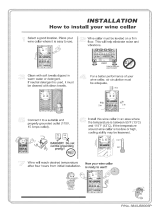
2
TABLE OF CONTENTS
WINE CELLAR SAFETY .................................................................3
Proper Disposal of Your Old Wine Cellar ....................................3
INSTALLATION INSTRUCTIONS..................................................4
Tools and Parts ............................................................................4
Custom Overlay Frame ................................................................4
Location Requirements................................................................5
Electrical Requirements ...............................................................5
Unpack the Wine Cellar ...............................................................5
Install Custom Overlay Frame......................................................6
Door Closing.................................................................................7
Base Grille ....................................................................................8
WINE CELLAR USE........................................................................8
Normal Sounds ............................................................................8
Using the Control .........................................................................8
Wine Racks...................................................................................9
Stocking the Wine Cellar..............................................................9
Lighting the Wine Cellar ...............................................................9
WINE CELLAR CARE ...................................................................10
Cleaning......................................................................................10
Changing the Light Bulb.............................................................10
Vacation and Moving Care.........................................................10
TROUBLESHOOTING ..................................................................11
ASSISTANCE OR SERVICE.........................................................12
In the U.S.A. ...............................................................................12
In Canada ...................................................................................12
Accessories ................................................................................12
WARRANTY ..................................................................................13
ÍNDICE
SEGURIDAD DE LA BODEGA.....................................................14
Cómo deshacerse adecuadamente de su bodega vieja...........14
INSTRUCCIONES DE INSTALACIÓN.........................................15
Piezas y herramientas................................................................15
Marco recubierto a la medida....................................................15
Requisitos de ubicación.............................................................16
Requisitos eléctricos..................................................................16
Desempaque de la bodega........................................................17
Cómo instalar el marco recubierto a la medida ........................17
Cómo cerrar la puerta ................................................................19
Rejilla de la base ........................................................................19
USO DE LA BODEGA...................................................................19
Sonidos normales ......................................................................19
Uso del control...........................................................................20
Portabotellas ..............................................................................20
Cómo almacenar en la bodega..................................................21
Cómo iluminar la bodega...........................................................21
CUIDADO DE LA BODEGA..........................................................21
Limpieza .....................................................................................21
Cómo cambiar el foco................................................................22
Cuidado durante las vacaciones y mudanzas...........................22
SOLUCIÓN DE PROBLEMAS......................................................23
AYUDA O SERVICIO TÉCNICO...................................................25
En los EE.UU. .............................................................................25
En Canadá..................................................................................25
Accesorios..................................................................................25
GARANTÍA.....................................................................................26
TABLE DES MATIÈRES
SÉCURITÉ DE LA CAVE À VIN....................................................27
Mise au rebut de votre vieille cave à vin....................................27
INSTRUCTIONS D’INSTALLATION ...........................................28
Outillage et pièces......................................................................28
Cadre décoratif personnalisé.....................................................28
Exigences d’emplacement.........................................................29
Spécifications électriques..........................................................29
Déballage de la cave à vin .........................................................30
Installation du cadre décoratif personnalisé..............................30
Fermeture de la porte.................................................................32
Grille de la base..........................................................................32
UTILISATION DE LA CAVE À VIN ...............................................32
Sons normaux ............................................................................32
Utilisation de la commande .......................................................33
Casiers à vin ...............................................................................33
Stockage dans la cave à vin ......................................................34
Éclairage de la cave à vin...........................................................34
ENTRETIEN DE LA CAVE À VIN..................................................34
Nettoyage ...................................................................................34
Changement de l'ampoule d'éclairage......................................35
Précautions à prendre pour les vacances
et avant un déménagement .......................................................35
DÉPANNAGE.................................................................................36
ASSISTANCE OU SERVICE.........................................................38
Aux États-Unis............................................................................38
Au Canada..................................................................................38
Accessoires ................................................................................38
GARANTIE.....................................................................................39




















